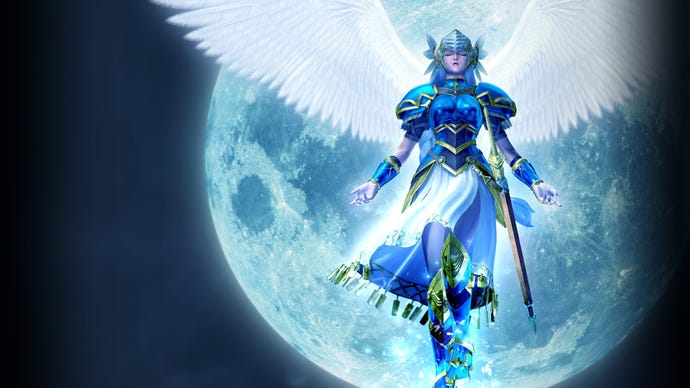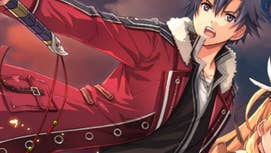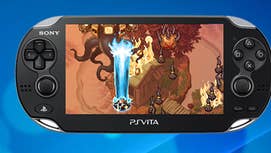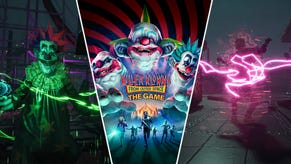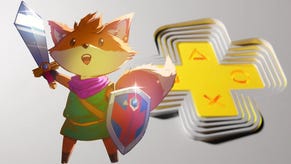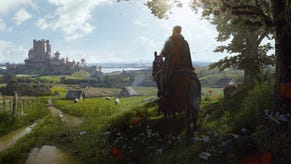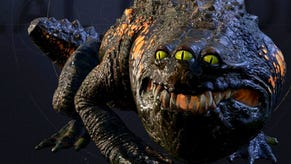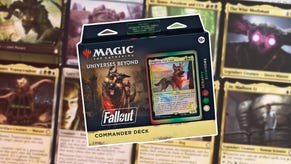The Baroque Beauty of Valkyrie Profile, Tri-Ace's Greatest RPG
Now 20 years old, Valkyrie Profile is one of the PlayStation's finest RPGs.
This article first appeared on USgamer, a partner publication of VG247. Some content, such as this article, has been migrated to VG247 for posterity after USgamer's closure - but it has not been edited or further vetted by the VG247 team.
"I think the fun part of games comes from thinking for yourself," Director Yoshiharu Gotanda is purported to have said of Valkyrie Profile (via an interview preserved by Shmuplations). Long before Dark Souls delighted and baffled fans with its deliberately opaque lore, Valkyrie Profile was making its best ending as counterintuitive as possible. The only hint of what needed to be done was in the title, summed up in a manner similar to the Nerv slogan from Neon Genesis Evangelion: "Should Deny The Divine Destiny of the Destinies," or more simply, "Reject Your Fate."
These days, Valkyrie Profile is mainly remembered for its rarity in North America, with most copies selling for more than $300 on Ebay owing to its very limited print run. But it's much more than just a cult curiosity for the PlayStation. As one of the very best games of that era, it's an RPG that stands tall alongside classics like Suikoden and Final Fantasy 7, and the audacity of its design is a big reason why.
First released in Japan in late 1999, Valkyrie Profile stood out from its peers in a number of key respects. Rather than a straightforward, linear tale, Valkyrie Profile was instead broken into a series of vignettes, at the end of which a warrior died and was recruited into the titular valkyrie's army. It eschewed the 3D polygons that had been popularized by Final Fantasy 7 for a more traditional sprite-based approach, and its combo-based battle system was a mix of real-time and turn-based combat, with a series of button presses corresponding to attacks from different party members.
It was this unique approach that captured my attention when I read about Valkyrie Profile back in 2000, prior to its release in North America. Intrigued, I picked up Valkyrie Profile at launch, where it rapidly became one of my favorite RPGs ever—possibly even my favorite game, period. I played through it at least a half-dozen times, first on normal, then on hard, each time discovering new wrinkles, new characters, and new dungeons. It could be an unforgiving experience, especially when battling enemies wielding great magic, but that only made me more determined to unlock its secrets.
Playing Valkyrie Profile, one is immediately grabbed by its sense of mystery; the feeling that not all is as it seems. In its opening prologue, we see a young girl named Platina flee in the night to avoid being sold to slavers, only to die in a meadow. After the title screen, we're introduced to Lenneth Valkyrie, who is dispatched to Midgard to recruit fallen warriors to assist Odin's forces in the battle of Ragnarok. From there, Valkyrie Profile is split into three distinct segments: exploration, recruitment, and dungeon crawling.
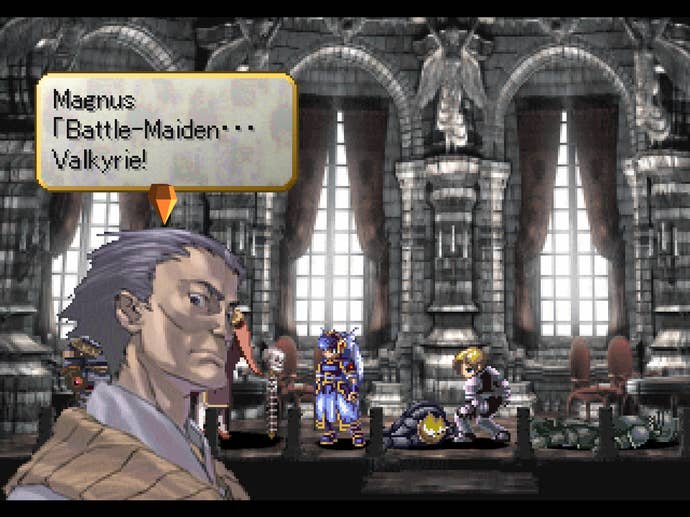
The recruitment and dungeon crawling elements are fairly straightforward: you watch a warrior die in some exceedingly depressing fashion, they're recruited to Lenneth's party, and then you level them up in a dungeon. The exploration is more opaque. You're free to fly around and check out various villages, but your time is limited, and there's rarely much benefit in descending to the mortal realm—not unless you know what you're looking for, anyway.
This element is the key to what makes Valkyrie Profile so special. If you simply follow the directions set before you, you will get the normal ending and that will be that. But if you're willing to, say, interrogate the meaning of the mysterious Seal Rating on Lenneth's stats screen, or investigate Brahms's castle, you will begin to unravel the mystery of Lenneth's identity. Only then does Valkyrie Profile's true story begin to reveal itself.
Many observers tend to criticize this element, arguing that the steps required to get the "good ending" basically demands a guide. Certainly, that was how I was ultimately able to see the so-called "A ending." With that said, getting the best ending isn't quite as complicated as critics make it out to be. When it comes down to it, there are only a few triggers that need to be hit, most of which are right there on the world map, begging to be investigated. Playing on Hard Mode, you're even given extra time to explore the map, giving you plenty of leeway to, say, see what the Weeping Lily Meadow is all about.
"The A ending was conceived for players who wanted to do things their own way and defy Odin. Thinking things through for yourself, and really questioning what the Seal Rate is all about, wanting to explore your past… if you do those things, you’ll reach the A ending. The conditions you have to achieve are really strict, and it may seem like aiming for the A ending from the beginning will be a very limited, confining experience, but it’s not like that at all, in fact," Gotanda reportedly said of the ending in the interview translated by Shmuplations. "I think there's been many games recently that are too kind to the player, and try to explain everything for them. In turn a game is now said to be 'unfriendly' or unfair if it doesn’t explain everything for you. But I think the fun part of games comes from thinking for yourself."
Left unsaid by Gotanda is that this approach also seems clearly geared toward encouraging replayability. A normal Valkyrie Profile playthrough can be wrapped up in about 25 hours, after which it's natural to try out the Hard difficulty. If you pay careful attention to the clues in your initial run, and you're willing to break from the path set for you, then it's possible to get the best ending on your own after some experimentation. But even if you use a guide, as I did, it's still rewarding to see Lenneth gradually wake to the reality of her situation.
What's still striking to me after all this time is the meta element of Valkyrie Profile's design—an element that I've only seen repeated in a few other games, including Undertale. After all, it's not just Lenneth who's in the dark, but you, the player. If you follow the game's instructions, you will be showered with praise and loot. Going the other way is quite a bit harder. Breaking from the path set for you is counterintuitive; the equivalent of ignoring not just a game's waypoint indicator, but every single bit of information about your character and motivation. In that, you and Lenneth are one in the same.
A Forgotten Legacy
There have been RPGs since that have set out to copy Valkyrie Profile's approach, but curiously, this meta journey of discovery is usually ignored, perhaps because it's viewed as too obtuse and complicated.
Instead, when a game like Indivisible says it's a modern tribute to Valkyrie Profile, it usually means that it's copying its battle system, which is flashy but slightly tedious (you see that unskippable Nibelung Valesti animation a lot in Valkyrie Profile). Even Valkyrie Profile itself has gotten away from this core element in some ways. Its PlayStation 2 sequel, Valkyrie Profile 2: Silmeria, was a much more traditional JRPG—competent but otherwise fairly disappointing.
The meta-design isn't the only feature that gets lost in self-described successors like these; it's Valkyrie Profile's worldbuilding and sense of sweep as well. Events are always in motion throughout Valkyrie Profile, as wars are fought, heroes die, and villains like Lezard Valeth, Queen Hel, and Gandar enact their various schemes. A running plotline has Celia, a mercenary trying to survive in a harsh world, watching as her friends die one by one. She seeks revenge for what she believes to be betrayal, but then breaks down as even that little bit of catharsis is denied her.
It's these moments that add color to Valkyrie Profile's world, making the einherjar, the warriors recruited to Lenneth's army, more vivid in turn. Often, they perish because they are caught up in machinations beyond their control; because bad decisions from the past catch up with them, or because they are simply unlucky. Sometimes they are able to make a heroic sacrifice and die on their own terms, but other times they die on a random adventure, stabbed to death by a monster they didn't expect to encounter.
With haunting tracks like "Night to the Twilight of Everything," and an art style that can best be described as a fusion of anime and baroque, the world of Valkyrie Profile takes on a flavor of dark fantasy that is rarely seen in other Japanese RPGs. It's a world where public executions are very much in vogue, and an army will massacre an entire city simply because a pickpocket stole from a noble.
It's a side of Valkyrie Profile that rarely gets discussed, but it's a big part of why it endures in my memory. It exemplifies an era of wild experimentation in the RPG genre, in which Japanese developers set out to tell ambitious stories while subverting the foundation on which they were built. Like Moon and other RPGs of that era, Valkyrie Profile didn't want to be just another Final Fantasy or Dragon Quest—it wanted to be something much more. It's a shame that its successors have never been able to capture that same spirit.
The Power of Creation
In celebration of the 20th anniversary of Valkyrie Profile's release in North America, which was in August, I recently streamed a playthrough of tri-Ace's opus, playing on the Normal difficulty and achieving the best ending. I'll admit that I was a little nervous going in, afraid that its long, unskippable vignettes and repetitive battle system would spoil my fond memories of it. I needn't have worried.
Picking it up again for the first time in 15 years, I was pleased to discover that its sprite art is more beautiful than ever; its tragic vignettes just as affecting, and its battle system deeper than expected. I enjoyed digging into some of its more esoteric elements, particularly its wide variety of skills, and found myself pleasantly surprised by its brisk pace (about 20 hours all told). It can be a bit unforgiving in that old-school RPG kind of way, especially when it comes to its lengthy, labyrinthine dungeons, but not so tough that it's completely inaccessible.
Certainly, it's an odd RPG. In trying to tell an epic, sweeping story, it leaves several plot threads unresolved, which keeps the story from feeling fully self-contained. It's also hard to know what to make of Lezard Valeth, the nerdy mage with a Lolita complex who spends much of the game stalking Lenneth. I guess it's good that he's (mostly) a villain, but practically every one of his scenes had me audibly exclaiming, "Gross!" Then there's the English voice acting, which is famously heavy on veterans from Saturday morning kids anime like Pokemon and Yu-Gi-Oh. Veronica Taylor, best-known for playing the original iteration of Ash Ketchum, voices at least four major characters, two of whom are just a copy-paste of Ash. The cheesiness can be charming in its own way, but it also serves to undercut some of the darkness that makes its world so memorable.
Still, I came away with my warm feelings for Valkyrie Profile renewed. In my mind it sits at the upper echelon of the original PlayStation's library, buoyed by its unique structure and storytelling that's by turns epic and melancholy. Certainly, you won't find another RPG in the PlayStation's library like Valkyrie Profile—or anywhere, really.
Sadly, with few exceptions, the original Valkyrie Profile is mostly lost to history. It was ported to PSP in 2005, but being based on the Japanese version it lacks the quality-of-life improvements found in the English version, like the ability to sort items in the inventory. The iOS version, meanwhile, is dogged by bugs and poor touchscreen controls. With no PSN release forthcoming, Valkyrie Profile is harder to play than ever.
Still, the series lives on in the memories of its fans, particularly in Japan. Last year, the original cast came together to celebrate Valkyrie Profile's anniversary, which included a Star Ocean x Valkyrie Profile cafe and other events. Fans keep pestering Square Enix for an HD remake (hopefully better than the one afforded Secret of Mana), and every so often we get a cryptic quote from its original developers saying how much they'd love to revisit the series.
For now, though, the series remains dormant, its latest release being a middling mobile release called Valkyrie Anatomia. Outside of that, Square Enix seems to have little interest in reviving the franchise. With luck, there may be a day where Valkyrie Profile rejects this fate as well. But even if Lenneth's story is done and a remake never happens, its legacy as tri-Ace's single greatest RPG will remain engraved upon the genre's soul.
Header image credit: Alec Nishiki
